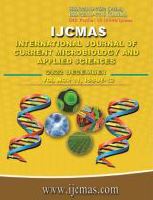


 National Academy of Agricultural Sciences (NAAS)
National Academy of Agricultural Sciences (NAAS)

|
PRINT ISSN : 2319-7692
Online ISSN : 2319-7706 Issues : 12 per year Publisher : Excellent Publishers Email : editorijcmas@gmail.com / submit@ijcmas.com Editor-in-chief: Dr.M.Prakash Index Copernicus ICV 2018: 95.39 NAAS RATING 2020: 5.38 |
1Laboratory of Biocatalysis and Bioprocesses, Nangui Abrogoua University (Abidjan, Côte d'Ivoire), 02 BP 801 Abidjan 02, Côte d’Ivoire
2Laboratory of Biotechnology, Felix Houphouet Boigny University, 22 BP 582 Abidjan 22, Côte d’IvoireThe objective of this study was to evaluate the anti-nutrient and organic acid content of the seeds of three legumes of the genus Canavalia according to their maturity stage. The biological material used for the laboratory operations consisted of seeds and pods at different stages of maturity harvested from a field in the Gbèkê region, central Côte d'Ivoire. Seeds of the three cultivars were harvested at different stages of maturity: 30 days (S1), 40 days (S2), 50 days (S3), 60 days (S4) and 80 days (S5) after fertilisation. The seeds are dried and ground to obtain the raw meal. The content of anti-nutrient compounds was studied using standard colorimetric methods, while the distribution of organic acids was carried out using HPLC analytical methods. The composition of anti-nutrients showed that their content decreased during ripening from stage S1 to stage S5 with the lowest contents, respectively for Canavalia gladiata, Canavalia rosea and Canavalia ensiformis being : 33.49 ± 0.06, 32.06 ± 0.06, 21.23 ± 0.06 mg/100g DM for phytates; 257.15 ± 0.06, 141.48 ± 0.07, 177.42 ± 0.06 mg/100g DM for oxalates; 1.39 ± 0.05, 1.67 ± 0.01, 1.09 ± 0. 01 mg/100g DM for saponin; 449.17 ± 5.54, 442.50 ± 5.38, 546.67 ± 2.98 mg/100g DM for L-dopamine and 98967.42 ± 3.27, 866.71 ± 3.19, 437.67 ± 1.99 trypsin units inhibited by trypsin inhibitors. With regard to the content of organic acids at all stages of maturity, it is noted that the predominant for the extracts of C. gladiata and C. rosea is lactic acid (0. 05 to 3.68 mg/kg DM and 0.03 to 4.02 mg/kg DM) followed by acetic acid (0.03 to 3.06 mg/kg DM and 0.01 to 2.11 mg/kg DM) and oxalic acid (0.01 to 2.76 mg/kg DM and 0.01 to 1.54 mg/kg DM).
 |
 |
 |
 |
 |